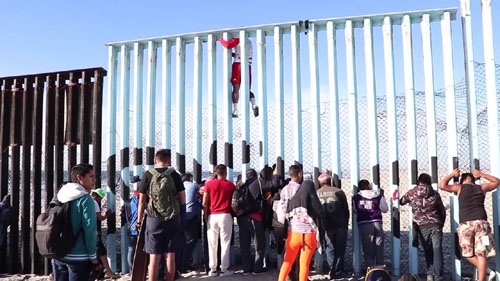by WorldTribune Staff, May 9, 2019
The hundreds of thousands of immigrants who have entered the U.S. since September include more than 1 percent of the entire populations of Honduras and Guatemala, according to the Department of Homeland Security (DHS).
“The current migration flows, especially of vulnerable families and children, from Central America through Mexico, to remote areas all along the U.S. border, represent both a security and humanitarian crisis. The situation is not sustainable,” acting Homeland Security Secretary Kevin McAleenan told the 49th Washington Conference of the Americas on May 7.

McAleenan also cited a recent USAID funded study conducted by Vanderbilt University’s Latin American Public Opinion Project in Guatemala earlier this year which found “1 in 4 Guatemalans have an intention to migrate from Guatemala, with 85 percent of them expressing the United States as their preferred destination.”
“That’s over 4 million Guatemalans who intend to migrate to the United States,” McAleenan said. “Imagine if almost the entire population of a state in the western United States left the country. What kind of impact would that have on the economy, culture, and identity? What does that mean for future generations?”
McAleenan said “The main cause of the current increases is the weakness in the U.S. immigration system, the vulnerabilities of our legal framework, which allow migrants, especially families and unaccompanied children, to stay in the U.S. for months or years, even though the vast majority will not ultimately receive legal status.”
Immigration and Customs Enforcement (ICE) has released 168,000 illegal immigrant family members into the U.S. this fiscal year, the acting chief of U.S. Immigration and Customs Enforcement’s deportation branch told Congress on May 8.
It is expected that about 87 percent of released families will skip their court hearings, leaving judges to order them deported in absentia.
Nathalie R. Asher told Congress that more funding and legal tools will be needed to stop the surge of illegal immigration and to track down those already ordered deported and who remain in the country.
McAleenan noted that “In March, we had over 103,000 irregular arrivals of undocumented migrants — 90 percent crossing the U.S. border unlawfully and unsafely in the hands of human smugglers. We will see similar numbers in April.”
Investigative reporter Sara Carter noted on May 9 that Border Patrol agents in the Yuma Sector on May 6 alone had “encountered and apprehended over 700 illegals.” The Yuma Sector agents made over 1,500 apprehensions over a three-day period, according to Arizona Customs and Border Patrol (CBP).
On April 16, Yuma Mayor Douglas Nicholls declared a local emergency as detention facilities continued overflowing. A congressional delegation which visited the Yuma Sector last month reported it found a facility designed for 250 people was holding 750.
Arizona Republican Sen. Martha McSally has called on the Senate to provide the $4.5 billion emergency funding President Donald Trump is seeking to combat the immigration crisis.
In a letter to Senate leaders, McSally said that the surge of illegals is crushing CBP and local towns struggling to accommodate the thousands crossing the border.
“Communities on the border are facing a humanitarian and public safety crisis caused by an increase in people, mainly unaccompanied minor children and migrant family units, seeking to enter the country without authorization,” McSally wrote in a letter to Senate Majority Leader Mitch McConnell, Senate Minority Leader Chuck Schumer, and the top Republican and Democrat of the Appropriations Committee.
The senator asked that the Trump plan be added to the emergency disaster funding plan under consideration.
McSally wrote: “This influx of family units and unaccompanied minors, many of whom require medical attention after an arduous and dangerous journey from Central America has put a significant strain on the Department of Homeland Security and Department of Health and Human Services resources. CBP officers and agents take more than 60 migrants to hospitals every day and has dedicated over 100,000 hours of officer and agent time to transporting migrants to and watching them at hospitals.”
And locally, the surge is taxing towns, she said.
“The sheer numbers of migrants being released after processing by CBP components has also overwhelmed state and local government and non-governmental organizations that help feed, shelter, and care for migrants,” wrote McSally.
Your Intel Brief: Geostrategy-Direct __________ Fix The Media Now
